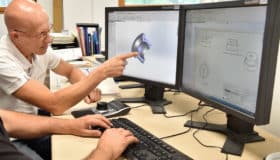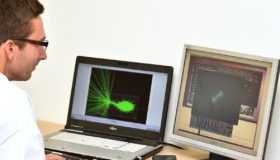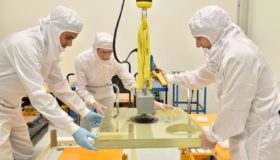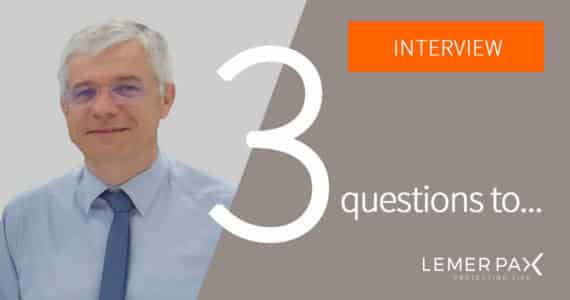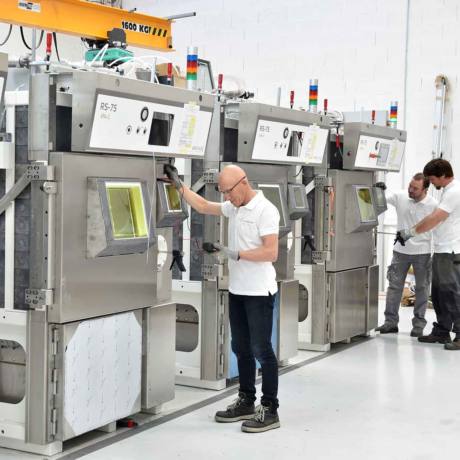
Lemer Pax-CEA-Rosatom, the winning troika at the WNE
With the signature of two major partnerships with the CEA and Rosatom, Lemer Pax is once again demonstrating the extent of its know-how in the design and manufacture of biological protections at all levels of the life cycle of a nuclear or research facility:
– In the early phases, with the deployment of 4 hot cells for the radiosynthesis of fluorine 18 and carbon 11 delivered to the CEA this month
– And in the later phases, with the design of a pneumatic radioactive sample transfer system for the Rosatom fuel treatment centre in Krasnoyarsk, east of Moscow.
The company will present this expertise at the WNE in the French pavilion next week.
Code name CAor and Lotus: a new generation of hot cells that protect both operators and the environment
The CEA’s goal is to offer an integrated solution for the production of radionuclides and the synthesis of innovative radiopharmaceuticals “by the dose” that can be scaled up quickly to facilitate the emergence of novel radiopharmaceuticals in clinical practice.
With the new regulations and standards constantly evolving towards a higher level of safety for both personnel and the environment, the CAor and Lotus programs come just at the right time to upgrade the radiopharmaceutical production sector of Orsay’s laboratories. Lemer Pax was identified as the best partner to meet the ambitious specifications.
Philippe Gervais, PhD in radiopharmacy and international expert with the CEA – head of the CAor project and consultant for the Lotus micro fluidics project – is extremely pleased about this technological and qualitative leap forward which will improve the overall safety and working comfort of the personnel concerned.
“Today, we are concerned about protecting operators, but we are also very concerned about the environment. These hot cells are therefore entirely sealed to prevent transfers between the hot cell environment and the outside. During synthesis, the gas compression system connected to the cell exhaust system confines the gas, which could potentially be radioactive, and then allows it to decay before releasing it into the atmosphere.
These hot cells are class C in class C premises. The circuits in the labs and buildings have been reviewed and corrected to achieve greater partitioning and keep the flows separate.
By upgrading our radiopharmaceutical drug production sector with the installation of two Fluor 18 (75 mm lead) and two carbon 11 (75 mm lead) hot cells, we will be able to quickly custom-manufacture a radiopharmaceutical preparation that can be administered to humans. From the time the cyclotron is started until the syringe is ready to be administered, less than 45 minutes should pass with fully customized markers and Fluo 18 and carbon 11 radioisotopes. Companies such as PMB, Evéon, Lemer Pax, and the CEA are bringing all their experience and technological expertise to this project for radiopharmaceutical administration in humans. Amongst ourselves, we jokingly refer to it as the Nespresso of radiopharmaceuticals. This is the major advance of recent years: the market authorization for FDG was very general, but today we are delivering personalized medicine.”
The new Lemer Pax hot cells will be installed in early July and will be operational before the end of the year.
A sophisticated and ingenious system that illustrates innovative French expertise
Rosatom, one of the world’s leading nuclear technology businesses, brings together companies involved in every stage of the technology chain, from uranium mining and enrichment to design, production and recycling of nuclear fuel. For Rosatom’s Krasnoyarsk site, Lemer Pax and its distributor JSC KOMFINSERVICE will deliver a complete nuclear grade stainless steel vacuum transfer system for two-way transfer of shuttles containing fuel samples between hot cells. This is an ingenious and sophisticated system designed by Lemer Pax’s design office, in record time, to guarantee the safe transfer of radioactive sources between different shielded hot cells. Composed of a network 1500 meters long, equipped with 23 sending and receiving stations, the system will be installed at the end of the year at the Russian site in Central Asia.
In addition, Lemer Pax designed and built a brand new sampling system for highly corrosive radioactive fluid, with one to ten channels, including a highly precise weighing and encapsulation system, all controlled via remote manipulation ball joints.
This French-Russian collaboration, worth several million euros, illustrates the innovative French expertise forged year after year at Lemer Pax in Nantes. Lemer Pax also designed and developed the critical components such as the viewing windows and the manipulation ball joints for the hot cells (150 mm lead) at this new site.
